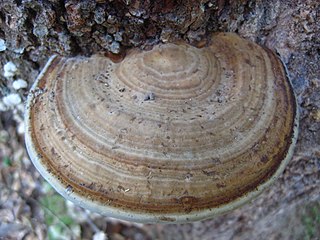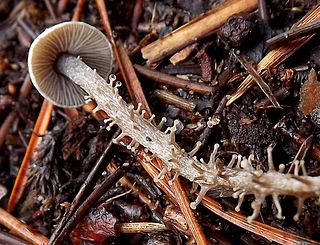
A mushroom or toadstool is the fleshy, spore-bearing fruiting body of a fungus, typically produced above ground, on soil, or on its food source. Toadstool generally denotes one poisonous to humans.

Ascomycota is a phylum of the kingdom Fungi that, together with the Basidiomycota, forms the subkingdom Dikarya. Its members are commonly known as the sac fungi or ascomycetes. It is the largest phylum of Fungi, with over 64,000 species. The defining feature of this fungal group is the "ascus", a microscopic sexual structure in which nonmotile spores, called ascospores, are formed. However, some species of Ascomycota are asexual and thus do not form asci or ascospores. Familiar examples of sac fungi include morels, truffles, brewers' and bakers' yeast, dead man's fingers, and cup fungi. The fungal symbionts in the majority of lichens such as Cladonia belong to the Ascomycota.
An ascocarp, or ascoma, is the fruiting body (sporocarp) of an ascomycete phylum fungus. It consists of very tightly interwoven hyphae and millions of embedded asci, each of which typically contains four to eight ascospores. Ascocarps are most commonly bowl-shaped (apothecia) but may take on a spherical or flask-like form that has a pore opening to release spores (perithecia) or no opening (cleistothecia).

Polypores are a group of fungi that form large fruiting bodies with pores or tubes on the underside. They are a morphological group of basidiomycetes-like gilled mushrooms and hydnoid fungi, and not all polypores are closely related to each other. Polypores are also called bracket fungi or shelf fungi, and they characteristically produce woody, shelf- or bracket-shaped or occasionally circular fruiting bodies that are called conks.

Sordaria fimicola is a species of microscopic fungus. It is commonly found in the feces of herbivores. Sordaria fimicola is often used in introductory biology and mycology labs because it is easy to grow on nutrient agar in dish cultures. The genus Sordaria, closely related to Neurospora and Podospora, is a member of the large class Sordariomycetes, or flask-fungi. The natural habitat of the three species of Sordaria that have been the principal subjects in genetic studies is dung of herbivorous animals. The species S. fimicola is common and worldwide in distribution. The species of Sordaria are similar morphologically, producing black perithecia containing asci with eight dark ascospores in a linear arrangement. These species share a number of characteristics that are advantageous for genetic studies. They all have a short life cycle, usually 7–12 days, and are easily grown in culture. Most species are self-fertile and each strain is isogenic. All kinds of mutants are easily induced and readily obtainable with particular ascospore color mutants. These visual mutants aid in tetrad analysis, especially in analysis of intragenic recombination.

The Xylariaceae are a family of mostly small ascomycetous fungi. It is one of the most commonly encountered groups of ascomycetes and is found throughout the temperate and tropical regions of the world. They are typically found on wood, seeds, fruits, or plant leaves, some even associated with insect nests. Most decay wood and many are plant pathogens.

Gymnosporangium juniperi-virginianae is a plant pathogen that causes cedar-apple rust. In virtually any location where apples or crabapples (Malus) and eastern red cedar coexist, cedar apple rust can be a destructive or disfiguring disease on both the apples and cedars. Apples, crabapples, and eastern red cedar are the most common hosts for this disease. Similar diseases can be found on quince and hawthorn and many species of juniper can substitute for the eastern red cedars.

Xylaria polymorpha, commonly known as dead man's fingers, is a cosmopolitan saprobic fungus. It is characterized by its elongated upright, clavate, or strap-like stromata poking up through the ground, much like fingers.

Kretzschmaria deusta, commonly known as brittle cinder, is a fungus and plant pathogen found in temperate regions.

Fomes fasciatus, common name the Southern Clam Shell, is a pathogenic white rot fungus in the family Polyporaceae. It is found in the southeastern United States and Central and South America where it can be seen growing on various dead and living hardwood trees. It was first described by Swedish botanist Olof Swartz in Jamaica in 1788 as Boletus fasciatus. It was later transferred by Cooke to Fomes fasciatus in 1885. The genus name "Fomes" translates to tinder as its holotype was historically used to start fires and the specific epithet "fasciatus" translates to "banded", in reference to the bands of brown to grey and black colors that the top of its fruiting body displays.

Phellinus igniarius, commonly known as the willow bracket, fire sponge,false tinder polypore, or false tinder conk, is a fungus of the family Hymenochaetaceae. Like other members of the genus of Phellinus, it lives by saprotrophic nutrition, in which the lignin and cellulose of a host tree is degraded and is a cause of white rot.

Harpella forficella is a species of the concealer moth family (Oecophoridae), wherein it belongs to subfamily Oecophorinae.

Ascocoryne sarcoides is a species of fungus in the family Helotiaceae. The species name is derived from the Greek sarkodes (fleshy). Formerly known as Coryne sarcoides, its taxonomical history has been complicated by the fact that it may adopt both sexual and asexual forms. Colloquially known as jelly drops or the purple jellydisc, this common fungus appears as a gelatinous mass of pinkish or purple-colored discs. Distributed widely in North America, Eurasia, and Oceania, A. sarcoides is a saprobic fungus and grows in clusters on the trunks and branches of a variety of dead woods. Field studies suggest that colonization by A. sarcoides of the heartwood of black spruce confers some resistance to further infection by rot-causing fungi. A. sarcoides contains the antibiotic compound ascocorynin, shown in the laboratory to inhibit the growth of several gram-positive bacteria.

Dendrocollybia is a fungal genus in the family Tricholomataceae of the order Agaricales. It is a monotypic genus, containing the single species Dendrocollybia racemosa, commonly known as the branched collybia or the branched shanklet. The somewhat rare species is found in the Northern Hemisphere, including the Pacific Northwest region of western North America, and Europe, where it is included in several Regional Red Lists. It usually grows on the decaying fruit bodies of other agarics—such as Lactarius and Russula—although the host mushrooms may be decayed to the point of being difficult to recognize.

Scorias is a genus of fungi within the Capnodiaceae family. The genus was first described by Elias Magnus Fries in 1832. The fungus is known as sooty mould and is found growing on honeydew on leaves of many varieties of trees and plants.

Spongiforma thailandica is a species of fungus in the family Boletaceae, genus Spongiforma. The stemless sponge-like species, first described in 2009, was found in Khao Yai National Park in central Thailand, where it grows in soil in old-growth forests. The rubbery fruit body, which has a strong odor of coal-tar similar to Tricholoma sulphureum, consists of numerous internal cavities lined with spore-producing tissue. Phylogenetic analysis suggests the species is closely related to the Boletaceae genera Porphyrellus and Strobilomyces.

Fomes fomentarius is a species of fungal plant pathogen found in Europe, Asia, Africa and North America. The species produces very large polypore fruit bodies which are shaped like a horse's hoof and vary in colour from a silvery grey to almost black, though they are normally brown. It grows on the side of various species of tree, which it infects through broken bark, causing rot. The species typically continues to live on trees long after they have died, changing from a parasite to a decomposer.

Xylobolus frustulatus, commonly known as the ceramic fungus or ceramic parchment, is an inedible species of crust fungus in the Stereaceae family. The fruit body forms small, hard, flat crust-like aggregations that resemble broken pieces of ceramic tile. These pieces are initially whitish before turning yellow-brown to gray-brown in age. The spore-bearing cells cover the upper surfaces of the fruit body. A saprobic species, it grows on well-decayed oak wood in Asia, northern Europe, and North America.

Amanita augusta is a small tannish-brown mushroom with cap colors bright yellow to dark brown and various combinations of the two colors. The mushroom is often recognizable by the fragmented yellow remnants of the universal veil. This mushroom grows year-round in the Pacific Northwest but fruiting tends to occur in late fall to mid-winter. The fungus grows in an ectomycorrhizal relationship with hardwoods and conifers often in mixed woodlands.
Triangularia setosa is a member of the Ascomycota, and of the genus Triangularia. This genus is notable for its widespread appearance on the excrement of herbivores, and is therefore seen as a coprophilous fungus. The fungus itself is characteristically dark in colour and produces sac-like perithecium with a covering of hair. Its dispersion involves the ingestion, passage, and projectile ejection of spores. It has preference for colonizing the dung of lagomorphs, such as hares and rabbits.


















